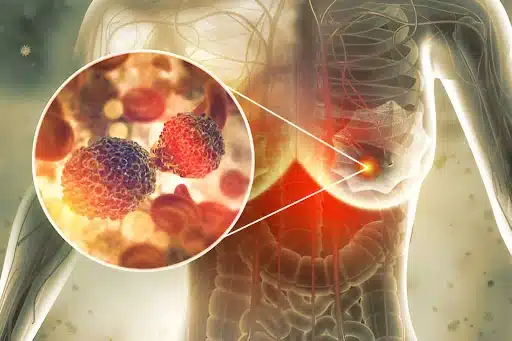Understanding Breast Cancer
Breast cancer is considered one the most common types of cancers that affect women globally. Although awareness of the disease has increased, many are unaware of the signs of breast cancer.
With advancements and early detection techniques, the mortality rate has significantly reduced. However, understanding the symptoms of breast cancer and early detection is the key to fewer complications and healthy recovery from the fatal disease.
Although the disease has been detected and treated as part of medical advancements, still more people are being diagnosed with the disease than ever before.
Explore with us early breast cancer signs to understand and detect the disease as early as possible.
| You beat cancer by how you live, why, and how you live. |
Common Breast Cancer Symptoms
Although not every lump or swelling is an indication of breast cancer, it is best to be aware and cautious of any physical changes. Some common signs are:
- Lump Or Thickening Mass
Upon self-examination, consult your doctor if you find a lump, mass, or thickening in the breast or underarm. These lumps or masses are often painless.
- Breast Pain Or Mastalgia
Breast pain, also known as Mastalgia, is commonly associated with menstrual cycle or hormonal activities. Still, if the pain is persistent and does not subside with the end of the menstrual cycle, then it is recommended that you take advice from your doctor.
- Breast Dimpling
The skin of the breast can reveal a lot about underlying health conditions. If the skin of the breast looks like an orange peel, puckered, or red, this may indicate an issue.
- Nipple Discharge
A discharge from the nipple, other than breast milk, especially if it’s bloody or clear, may require medical intervention.
- Nipple Retraction
If the nipple becomes retracted inwards or you notice that it becomes sunken, then it could be a symptom of breast cancer.
- Swelling Or Redness In Breast
Unusual swelling in the breast or underarms should be checked by a doctor as the swelling in the breast might indicate that cancer has spread to the lymph nodes.
Less Common But Important Signs

Here are some of the symptoms that are not so common but are important indicators of breast cancer.
- Change In Shape And Size Of Breast
If you notice any visible changes in the size or shape of the breast then it’s about time that you consult your Doctor. These changes don’t need to be accompanied by lumps or mass.
- Itchy Or Scaly Skin
Continuous itching or scaling on the breast skin could be a sign of breast cancer. These symptoms might occur on the skin as well as on or around the nipple. It is recommended that you not ignore these symptoms but consult your health provider immediately.
- Breast Lump
Although not very common, men can also develop breast cancer. Therefore, if you notice any lump or mass in your chest area then do consult your doctor.
- Pain In The Underarm Or Collarbone
The pain associated with these particular areas may indicate the spread of breast cancer. Therefore, if you feel persistent pain or discomfort in these areas then consult your doctor.
- Nipple Inversion
If you notice that the nipple becomes inverted then you should seek medical guidance.
- Visible Breast Vein
A sudden increase in the visibility of veins in the breast could be an indication of growing cancer. The change often occurs as the tumor requires blood supply to grow which leads to swollen or visible veins.
When To Seek Medical Attention
If you notice any of the above symptoms it is highly encouraged that you must seek medical guidance as soon as possible. Early detection is the key to prevention and successful treatment.
It must also be remembered that not all lumps or masses indicate breast cancer but, as they say, it is better to be safe than sorry.
FAQs
Q.1 Is breast cancer painful?
A.1 No, breast cancer is often painless. In many cases, patients have detected the lumps or masses during random self-examination. Pain is not always a reliable indicator of breast cancer.
Q.2 Can men get breast cancer?
A.2 Yes, while rare, men can develop breast cancer. The symptoms are usually the same as in women, including the lump in the chest area.
Q.3 What should I do if I find a lump in my breast?
A.3 If you find a lump in your breast it is best that you immediately consult your healthcare provider. They might suggest some imaging tests like mammograms or ultrasounds. Also, a biopsy could be recommended to find out whether the lump is cancerous or not.
Q.4 How often should I perform a breast self-exam?
A.4 It is recommended that you perform a breast self-exam once a month. This would help you become familiar with the normal look and appearance of the breasts and you would sooner notice any changes, occur.
Q.5 What if one ignores the symptoms of breast cancer?
A.5 Ignoring breast cancer symptoms might lead to delayed diagnosis and treatment which would ultimately result in diminished chances of successful treatment.
Q.6 How can I reduce my risk of breast cancer?
A.6 Although some of the risk factors can not be altered like genetic factors, you may reduce or minimize the risk by maintaining a healthy lifestyle, avoiding excessive alcohol, and exercising daily. You must also schedule regular screenings, especially if you have a family history of breast cancer.
Conclusion
Early detection is the first step toward healthy recovery in cases of breast cancer. You must be familiar with the symptoms and signs of it.
You must also remember that not all symptoms mean you have breast cancer. But, in case you notice any of the symptoms, you should seek guidance from a doctor.
Regular self-exams and scheduled screenings might be helpful if you have a family history of breast cancer. By doing regular self-exams you will enable yourself to listen to and understand the signals of your body.
We at Surgical Associates P.A. provide different kinds of breast cancer removal surgery services, with our decades of experience we have successfully saved hundreds of lives. Contact us today for more information or guidance.


